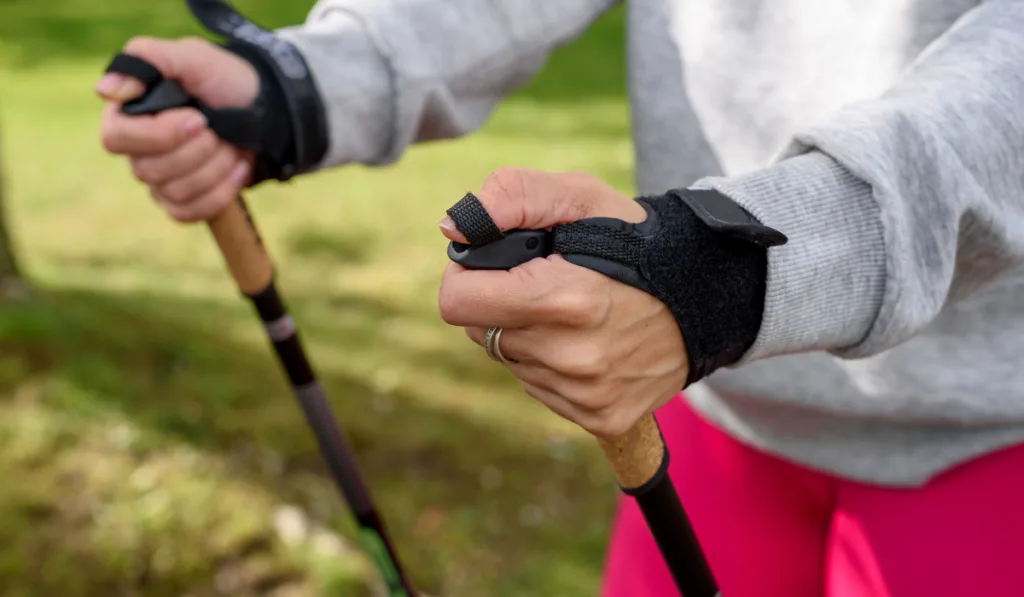Trekking poles are a must-have for hiking enthusiasts.
Whether you’re looking to traverse uneven terrain or enjoy better stability, a quality set of trekking poles can make your outdoor adventure more enjoyable.
Knowing what your trekking poles are made of is essential, especially if you’re looking for a sturdy and lightweight set. Carbon fiber and aluminum are the common materials of most poles, but which is better?
Our detailed guide explores the pros and cons of each material to determine if one material is better than the other.
Read on as we uncover factors like comfort, durability, weight, reliability, and more.

Table of Contents
Carbon Fiber Trekking Poles
Carbon fiber consists of strong woven fibers reinforced with epoxy or resin. Although this material has a high strength-to-weight ratio, it’s sturdy and lightweight.
Manufacturers make carbon fiber by processing a polymer into filaments of carbon atoms.
A ribbon is formed by combining thousands of filaments, and these ribbons are woven into sheets that are bound together.
The material is then passed through heat and shaped into tubes that go into making the trekking poles.
The process of making carbon fiber may differ from one manufacturer to another.
It all depends on the density of fibers, the thickness of the layers, the heat treatment used, fiber types, and more.
These factors will affect the material’s weight, durability, and stiffness. That means two carbon trekking poles from different manufacturers may not be similar.
A carbon fiber trekking pole is sturdy when you apply force from the top of the pole to the bottom. However, it can get weak when you apply force to the side of the pole.

Pros of Carbon Fiber
Some of the advantages of carbon fiber trekking poles include:
Lightweight
Carbon fiber is light, a factor that comes in handy when hiking long distances. Most carbon fiber poles range between 11 and 17 ounces a set.
You should opt for carbon fiber poles if you’re looking for something light to pack or need poles that are easier to carry around without the added weight.
Hikers going for a long hike will prefer this trekking pole as it allows them to move easily and fast.
Furthermore, carbon trekking poles are less flexible and feel solid on the ground. That allows you to move fast on slippery or rugged terrain.
Comfortable
Carbon fiber is less dense than aluminum, an aspect that allows it to dampen natural vibration. You can comfortably go on a hike without worrying about arm and hand fatigue.
Some manufacturers also add a suspension system to reduce the shocks and design a comfortable grip to make your hike easier.
Suitable for Occasional Use
If you are a hiker who doesn’t like to have trekking poles on your backpack for every hike, carbon fiber poles are an excellent alternative.
They are lightweight, and you can pull them out any time you wish.
Cons of Carbon Fiber Trekking Poles

Some of the disadvantages of carbon fiber poles are:
Expensive
Carbon fiber trekking poles are more costly than aluminum poles.
Although you can find budget carbon fiber poles at around $60, that’s still expensive compared to $30 for entry-level aluminum poles. A quality, high-end set of carbon fiber poles retails at $200.
Fragile
Carbon fiber poles are delicate and fragile by design. That makes them less durable compared to aluminum poles.
For example, hitting the pole on a rock can crack the carbon fiber, rendering it useless.
Bending the poles sideways, rubbing them against debris, or having the poles stuck in between rocks can also cause them to degrade over time.
Unlike aluminum which is scratch-resistant, carbon fiber is delicate and prone to cracks.
Risky to Use
The material’s fragile nature could risk serious injury if it breaks or cracks when you least expect it.
Carbon fiber poles could crack from heavy use or impact placed on them.
Inspecting your poles regularly for signs of cracks or broken fibers is essential. Avoid using them if there are any signs of damage on your poles.
Unfortunately, you can’t repair carbon fiber poles or use them when damaged.
They Cannot Be Used as Tent Poles
Most hikers love using trekking poles to support their tents.
However, due to carbon fiber’s delicate nature, that’s not a possibility as it could end up cracking. That could make it problematic to pitch your tent.
Additionally, you can’t use carbon fiber poles as ski poles as they can’t withstand the extra force. That makes them less versatile compared to aluminum trekking poles.

Aluminum Trekking Poles
Aluminum is another common material used in the manufacture of trekking poles.
Manufacturers don’t use pure aluminum but incorporate other elements like zinc to increase durability and strength.
You’ll see 7000-series and 7075 aluminum alloy when shopping for trekking poles. These are different types of aluminum used in manufacturing the poles, with 7075 being the most common.
Trekking poles made from aluminum like 6061 tend to be fragile and prone to breakage. They are also cheaper and heavier than those made from premium aluminum alloy.
Pros of Aluminum Trekking poles
Some of the advantages of aluminum trekking poles include:
Affordability
Aluminum poles are cheaper compared to carbon fiber trekking poles. You can get a high-end pole for $150 and a budget for $30. That makes them ideal for someone on a budget.
Durability
Another benefit of aluminum poles is their durability. They are designed to handle more impact and flexing, something you can’t get with carbon fiber poles.
Hikers on the heavier side will prefer aluminum poles as they can handle the weight. You don’t have to worry about scratches or abrasions damaging the poles.
These poles can withstand any falls or cracks. You won’t have to worry about replacing the poles often, which saves you money in the long run.
That also adds to their reliability as you don’t have to keep watching for cracks or scratches.
Aluminum trekking poles are also fantastic if you’re a regular hiker on rugged terrain.

Versatility
The ability to handle impact makes aluminum poles more versatile. You can use them to support a non-freestanding tent without worrying about cracks or damage.
Furthermore, you can use them for hiking on different terrain, snowshoeing, and skiing.
Another great feature is that you can still use the poles when they get damaged. Although bends and dents weaken the poles, they are still usable, unlike carbon fiber poles.
Cons of Aluminum Trekking Poles
Some of the disadvantages of aluminum trekking poles include:
Lack of Vibration Dampening Properties
Aluminum poles have a higher density, so they can’t absorb vibrations well like carbon fiber poles. Unfortunately, many vibrations can leave you fatigued after a long day of hiking.
While you can choose aluminum poles with a better grip or wear gloves, you’ll still feel some of the vibrations.
Tedious to Carry Around
Although aluminum poles are durable, they are also quite heavy, making them uncomfortable if you go on a long day hike.
Carrying these poles around can also leave you exhausted and slow your pace.

Don’t Feel as Sturdy
Unlike carbon fiber poles that feel stable and sturdy when planted in the ground, aluminum poles have more flex and are unstable.
You may need to rely on your feet more for balance, especially when traversing tough terrain.
Which is Better: Carbon Fiber vs. Aluminum Trekking Poles?
After comparing the two options, it’s safe to say that there isn’t one material that’s better than the other. It all boils down to your budget and preferences.
If you are a hiker on a budget and are looking for something affordable that is also reliable and versatile, aluminum trekking poles are an excellent option.
You should also opt for aluminum poles if you want something that can handle impact and flexing without bending.

Additionally, aluminum poles are perfect if you prefer hiking in cold weather and have to deal with slippery surfaces, as they are not sensitive to weather like carbon fiber.
However, for someone whose budget permits and prefers to carry a lighter weight, with carbon fiber trekking poles you don’t have to worry about the extra weight.
Hikers exploring flat trails will be better off with carbon fiber poles as they don’t have to handle a lot of impact on such trails.
Final Thoughts
When choosing trekking poles for your next hike, you need to consider your budget, durability, body weight/height, trail conditions, the poles’ weight, and the poles’ use.
Both aluminum and carbon fiber poles have their pros and cons, and your choice will depend on the above factors.
Resources
- https://www.treelinereview.com/howtochoose/trekking-poles
- https://www.gearx.com/blog/knowledge/hikingcamping/choose-trekking-poles/
- https://www.blasttags.com/carbon-fiber-vs-aluminum-trekking-poles/
- https://backpackinglight.com/forums/topic/29977/
- https://caverntours.com/aluminum-vs-carbon-fiber-trekking-pole/
- https://wheretheroadforks.com/carbon-fiber-vs-aluminum-trekking-poles-pros-and-cons/
- https://purehiker.com/aluminum-vs-carbon-fiber-trekking-poles/
- https://cascademountaintech.com/blogs/news/which-is-better-aluminum-or-carbon-fiber-trekking-poles
- https://cnocoutdoors.com/blogs/blog/carbon-fiber-vs-aluminum-for-trekking-poles-in-cold-weather
